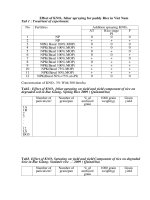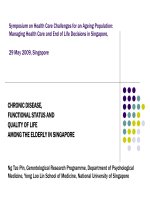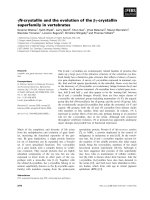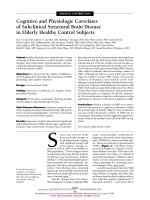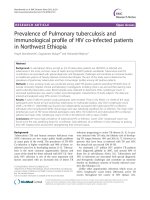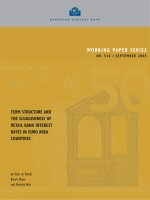ICTs and everyday communication of migrant female domestic workers in singapore
Bạn đang xem bản rút gọn của tài liệu. Xem và tải ngay bản đầy đủ của tài liệu tại đây (344.39 KB, 122 trang )
ICTs AND EVERYDAY COMMUNICATION OF
MIGRANT DOMESTIC WORKERS IN SINGAPORE
MINU THOMAS
(M.A. English, MADRAS UNIVERSITY, INDIA)
A THESIS SUBMITTED
FOR THE DEGREE OF MASTER OF ARTS
COMMUNICATIONS AND NEW MEDIA PROGRAMME
NATIONAL UNIVERSITY OF SINGAPORE
2008
Acknowledgements
“Feeling gratitude and not expressing it is like wrapping a present and not giving it.”
~William Arthur Ward
The writing of this thesis has been a new and wonderful experience for me. I would
like to thank my supervisor, Dr. Lim Sun Sun for her valuable time and guidance for
this study. Her constructive comments and constant encouragement has helped me
throughout the period of my candidature.
I would also like to thank the faculty and administrative staff of Communications and
New Media (CNM) Programme, who have always been there for me. Especially
Dr.Milagros Rivera, whose enthusiasm and love for learning initiated me into this
long journey of writing and research. I would also like to make a special mention of
Dr. Hichang Cho and Dr.Kevin Mc.Gee for their valuable insights during the
Research Methods classes.
Most importantly, I would like to thank all my respondents and their employers for
agreeing to participate in this study. Without their support, this thesis could not have
been completed.
Thanks, to my friends, especially Pratichi, Manjari and Nandini, for always being
there for me; and to my parents, my in-laws, and my siblings for their constant
support and encouragement during the past two years.
Finally, the most important person in my life, my husband Jayan, without whose
support this whole Masters programme at CNM would not have happened.
I thank him for his love, patience and guidance throughout my period at CNM, and
also for his constant support on the home front.
Thank you to all those who have helped me in this wonderful journey and whose
names I have not been able to mention.
Thank you.
ii
Table of Contents
Acknowledgements ......................................................................................................ii
Summary......................................................................................................................vi
List of Tables ...............................................................................................................ix
List of Abbreviations ...................................................................................................x
Chapter 1
Introduction..................................................................................................................1
1.1 Context for research ..........................................................................................1
1.2 Relevance for research ......................................................................................2
1.3 Research question and chapter organization ..................................................4
Chapter 2
Living and Working Conditions of Foreign Domestic Workers .................................6
2.1. History of migration of foreign domestic workers to Singapore ..................6
2.2 The role of migrant domestic workers in Singapore’s economy ...................8
2.3 State and migrant domestic workers in Singapore.......................................10
2.4. Conditions of work and living for migrant domestic workers....................11
2.5. Representations of migrant domestic workers in Singaporean society .....13
2.6. Everyday communication of migrant domestic workers ............................14
2.7 Conclusion ........................................................................................................16
Chapter 3
ICT and Society: A Review of Literature ...................................................................17
3.1 Introduction......................................................................................................17
3.2 Theoretical framework: Domestication of technologies..............................18
3.2.1 Development of domestication as a concept...............................................21
3.2.2 Consuming technologies .............................................................................22
3.2.3 Domestication and everyday life.................................................................25
3.2.4 Recent applications of the domestication concept in empirical studies .....26
3.3 Uses and gratifications perspective ................................................................27
iii
3.4. Women and the sociology of everyday life....................................................29
3.5 Research problem ............................................................................................30
3.6 Conclusion ........................................................................................................31
Chapter 4
Methodology ...............................................................................................................32
4.1 Ethnographic research ....................................................................................32
4.1.1 Meaning condensation ................................................................................33
4.1.2 Methodologies for previous research on domestic workers .......................34
4.2 Methodology used in this study ......................................................................35
4.2.1 Location of the Interviews and Some Limitations of the Methodology Used
..............................................................................................................................37
4.3 Profiles of Indian and Filipino workers interviewed ....................................39
4.4 Conclusion ........................................................................................................42
Chapter 5
Use and Domestication of ICTs by Migrant Female Domestic Workers..............43
5.1 Introduction......................................................................................................43
5.2 Pattern of use of technologies..........................................................................43
5.3 Proficiency levels in the use of technologies ..................................................48
5.3.1 Education ....................................................................................................50
5.3.2 Age ..............................................................................................................51
5.3.3 The specific need for using technologies as a determining factor..............52
5.4 Routes to domestication of technologies in migrant workers’ lives ............54
5.4.1 Incorporation ..............................................................................................54
5.4.2 Appropriation..............................................................................................55
5.4.3 Objectification.............................................................................................56
5.4.4 Pre-migration experience and domestication of technologies....................58
5.4.5 Factors influencing domestication of technologies ....................................62
5.5 Conclusion ........................................................................................................64
Chapter 6
Motivations and Gratifications of ICT Use .............................................................65
6.1 Introduction......................................................................................................65
iv
6.2 Companionship ................................................................................................67
6.2.1 Family ties...................................................................................................67
6.2.2 Friendship ties ............................................................................................69
6.3 Escape................................................................................................................70
6.4 Entertainment ..................................................................................................71
6.5 Information gathering .....................................................................................73
6.6 Conclusion ........................................................................................................75
Chapter 7
Impact of ICTs on Migrant Workers’ Lives ...........................................................76
7.1 Introduction......................................................................................................76
7.2 Empowerment ..................................................................................................77
7.3 Connectivity......................................................................................................80
7.4 Obligations arising from technology use........................................................83
7.8 Conclusion ........................................................................................................89
Chapter 8
Conclusion...................................................................................................................90
8.1 Summary of findings .......................................................................................91
8.2 Societal implications ........................................................................................99
8.3 Limitations and suggestions for future research.........................................100
8.4 Recommendations for future research.........................................................101
References.................................................................................................................103
v
Summary
A number of women from developing countries such as Philippines, Indonesia, Sri
Lanka and India have been migrating to major metropolitan centres of the world in
search of employment as domestic workers. These migrant women workers leave
their families and loved ones behind for periods ranging from a few months to many
years. The everyday communication of these women reflects the wide range of their
emotional and instrumental needs such as maintaining close ties with families and
friends and seeking information about new jobs. Information and communication
technologies (ICTs) such as the mobile phone and the Internet add a new dimension to
their everyday communication. This thesis has attempted to understand the use of
ICTs in the everyday communication of migrant domestic workers in Singapore.
The study is based on ethnographic research. The core data for this research is derived
from semi-structured interviews of 20 migrant women – 10 Filipinos and 10 Indians -working as domestic workers in Singapore.
Migrant female domestic workers constitute over one-fifth of Singapore’s foreign
workforce. Singaporeans, particularly working women with young children, are
highly dependent on their services. Reports, especially in the Singapore media, and
scholarly studies indicate that at least a small minority of foreign domestic workers in
Singapore have to endure difficult working conditions and tolerate physical abuse.
Given this context, the specific research questions that the thesis sets out to address
are related to (i) the pattern and motivations of use of ICTs by migrant women
vi
domestic workers in their everyday communication, and (ii) the ways through which
ICTs impact the lives of these workers.
The interviewed workers have been categorized into those with ‘high’, ‘moderate’,
and ‘low’ proficiency levels in the use of technologies. Our research findings
indicated that there is no clear association between age and proficiency level in the
use of technologies, or between years of migration to Singapore and proficiency
levels. Also, being more educated did not mean that proficiency levels were higher.
Instead, proficiency seemed to have been encouraged by the specific need for using a
particular technology.
This study seeks to apply the technology domestication theory and the uses and
gratifications theory as the conceptual framework to understand the pattern and
motivations of use of ICTs by migrant women domestic workers in their everyday
communication.
With respect to domestication of technologies, the study showed workers routinized
technologies and appropriated them to suit their specific needs, but the process of
objectification was absent. The social and economic conditions before migration have
an important bearing on the processes through which the workers domesticate
technology after their migration.
The major social or psychological needs that are satisfied by everyday communication
of workers through their use of different media are: companionship, escape,
entertainment, and information gathering. In fact, workers’ strategies of resistance and
vii
sites of power are closely linked to their everyday communication. Foreign domestic
workers build social networks, make telephone calls and write letters during their
limited leisure time. This is one of their means to reclaim some private space and
time. Contacts with other people help them sometimes to escape from abusive
employers and secure better employment opportunities
It was found that the major positive impacts of ICTs on workers’ lives were as a
source of empowerment and as an instrument for connectivity. At the same time, with
ICTs, the workers were bound by responsibilities to their family members, especially
to children whom they leave behind, and this was taking a considerable emotional and
financial toll on these women.
viii
List of Tables
Table 1: Estimates of the Number of Foreign Domestic Workers in Singapore, by their
Nationality, 1986-2004 ..................................................................................................7
Table 2: Female Labour Force Participation Rates in Singapore, 1957 to 2005, in per
cent.................................................................................................................................8
Table 3: Proportion of Dual-Career Couples among Married Couples .......................9
Table 4: Female Migrant Domestic Workers Interviewed, by Age..............................41
Table 5: Female Migrant Domestic Workers Interviewed, by Years of Migration .....42
Table 6: Female Migrant Domestic Workers Interviewed, by Years of Education .....42
Table 7: Profile of Filipino Workers Interviewed........................................................46
Table 8: Profile of Indian Domestic Workers Interviewed ..........................................47
Table 9: Proficiency Levels in Using Technologies of Migrant Female Domestic
Workers Interviewed, Criteria for Categorization.......................................................49
Table 10: Migrant Female Domestic Workers Interviewed, by Proficiency Levels in
Using Technologies, in Numbers .................................................................................49
Table 11: Sources of information about the outside world accessed by female migrant
domestic workers interviewed......................................................................................73
Table 12: Average Monthly Income and Average Monthly Expenses on
Communication Incurred, Indian and Filipino Workers .............................................86
Table 13: Migrant Female Domestic Workers Interviewed, Monthly Incomes and
Monthly Expenditures on Communication...................................................................88
ix
List of Abbreviations
ICT
Information and Communication Technologies
UNESCO United Nations Educational, Scientific and Cultural
Organisation
SMS
Short Message System
IDA
Infocomms Development Authority of Singapore
UNDP
United Nations Development Programme
BBC
British Broadcasting Corporation
x
Chapter 1
Introduction
This thesis attempts to study the use of information and communication technologies
(ICTs) by migrant women working as domestic workers in Singapore, hereafter to be
referred to as migrant domestic workers. My study is based on ethnographic research.
The core data for my research is derived from semi-structured interviews of 20
migrant women – 10 Filipinos and 10 Indians -- working as domestic workers in
Singapore.
1.1 Context for research
According to recent estimates, approximately 150,000 migrant women from countries
such as Indonesia, Philippines, Sri Lanka and India work as contract domestic maids
in Singapore (Dwyer, 2005, Abdul Rahman et al. 2005). Living and working
conditions of foreign domestic workers in Singapore have been the concern of a
number of scholarly studies and media reports. The picture that emerges from such
diverse sources is that at least a small minority of these women workers have to
endure difficult working conditions and tolerate physical abuse. In many instances,
foreign maids in Singapore are also made to work for long hours (Abdul Rahman et
al. 2005).
Studies indicate that in the case of some foreign domestic workers, the access to basic
necessities such as food, shelter, communication, medical facilities and the right to
private space and time are controlled by their employers. The employers also control
the domestic workers’ social activities and forays into public space. In the employers’
homes, the workers are treated neither as family members nor as total outsiders
1
(Abdul Rahman et al. 2005). In some homes, workers are under surveillance; there
have also been instances when they are prevented from forming any type of strong
ties with their families back home (Yeoh et al. 2005).
1.2 Relevance for research
This study on the use of ICTs by migrant women working as domestic workers in
Singapore assumes relevance in the above-discussed context, in two important
dimensions.
First, it is widely believed that ICTs are important tools for development and are a
source of empowerment for the underprivileged. The twin forces of ICTs and
globalization have powerful impacts on society and social relations, and these have
been analyzed by a number of scholars. Manuel Castells describes the ‘network
society’ to denote the societal changes brought about by the information technology
revolution (Castells, 1996).
There are differences of opinion as to whether the changes brought about by ICTs on
society are entirely beneficial or not. Some scholars note that the potential of ICTs to
reduce global inequalities -- between countries and within countries -- and societal
inequalities is very high (Heeks, 2002). At the same time, however, some other
studies have challenged this view. They point to the increase in inequalities between
skilled and unskilled workers in the ‘new economy’ or ‘informational economy’
(Wood, 1995; Parayil, 2005); and to the domineering weight of social, economic and
institutional factors (such as illiteracy, land distribution and caste) in determining
inequalities (Thomas and Parayil, 2008).
2
The second dimension that contributes to relevance for this research is the genderrelated aspect of development. In most developing and even developed countries,
women face several disadvantages owing to social, economic and cultural factors.
Amartya Sen, who described development as a ‘process of expanding the real
freedoms that people enjoy’, pointed to the existence of severe female disadvantage in
health and other aspects of well-being in many areas of the third world. The greater
deprivation of females, Sen (1999) noted, is linked to relatively low levels of female
literacy and absence of social and economic empowerment. In the age of the network
society, gender-based inequalities have come to be characterized also by the lack of
access to information and knowledge networks. Therefore, ICTs can play a useful role
in building information networks and empowering women who are otherwise
secluded (Nath, 2001).
Empowerment refers to the creation of an environment that enables selfdetermination, and for women, this applies to increasing their power and ‘taking
control over decisions and issues that shape their lives’ (Thas, Ramilo, and Cinco
2007, p.14). Studies have analyzed how ICTs ranging from community radio
broadcast to email can heighten women’s empowerment. For example, Somolu’s
(2007) study relates to the use of blogging by African women as a tool to promote
gender equality and empowerment. Through blogging, women get an opportunity to
write about what is important to them and in this way they became active creators and
disseminators of knowledge (Somolu, 2007).
The study of the owners (mainly
women) and users of the Village Phone in Bangladesh found that the Village Phone
helped to widen the social networks of almost all women –owners (Aminuzzaman et
al. 2003).
3
1.3 Research question and chapter organization
Given the above-discussed background, my research is an attempt to study the use of
ICTs by migrant women working as domestic workers in Singapore. My specific
research questions are related to (i) the pattern and motivations of use of ICTs by
migrant women domestic workers, and (ii) the impact of ICTs on the living and
working conditions of these workers. Detailed research questions will be given at the
end of Chapter 3 after an extensive review of the relevant literature.
The second chapter of this thesis discusses the empirical literature on the living and
working conditions of migrant workers in Singapore. It begins with a historical
review of the migration of these workers from 1819 into Singapore. It highlights the
important role played by these migrant workers in Singapore’s economy; and
discusses the attitude of the state and society in Singapore towards these migrant
workers. The chapter also illustrates the importance of their everyday communication
as they face many hardships in a foreign country.
Chapter three elucidates the two main theories on which the research questions have
been based. The two theories discussed and applied in this study are technology
domestication theory and the uses and gratifications perspective. The first theory has
been used to analyze how the migrant workers domesticate the different technologies
they use into their daily lives. The uses and gratifications perspective theorizes how
the migrant domestic workers use ICTs and the gratifications which they derive from
this use, given their individual social or psychological needs. This chapter also draws
insights from literature on women and the sociology of everyday life.
4
The fourth chapter discusses the methodology used in this study. Chapter five
analyzes the pattern of communication among the migrant domestic workers in
Singapore. The different technologies they employed, especially the mobile phone,
are discussed in detail. The workers are categorized according to their proficiency
levels in using the different technologies; the proficiency levels are further analyzed
on the basis of workers’ age, education and years of migration. The concept of
domestication of technologies is discussed in relation to the experiences of the
migrant domestic workers interviewed.
Chapter six illustrates the motivations behind the domestic workers’ use of particular
technologies. The uses and gratifications perspective will be used to analyze the
gratifications which these workers derive from the use of the different technologies.
Chapter seven analyzes whether ICTs are a source of empowerment for the migrant
female domestic workers. At the same time, the chapter discusses the obligations
arising from technology use: greater familial responsibilities and the high costs of
mobile phone use. Chapter eight concludes the whole study by summarizing the
research findings and provides recommendations for further research.
5
Chapter 2
Living and Working Conditions of Foreign Domestic Workers
This chapter reviews the literature on living and working conditions of migrant female
domestic workers in Singapore. In different sections of this chapter, we discuss the
history of migration of foreign domestic workers to Singapore (section 2.1); the role
of migrant domestic workers in Singapore’s economy (section 2.2); state and migrant
domestic workers in Singapore (section 2.3); conditions of work and living for
migrant domestic workers (section 2.4); representations of migrant domestic workers
in Singaporean society (section 2.5); and everyday communication of domestic
workers (section 2.6). Section 2.7 is the concluding section.
2.1. History of migration of foreign domestic workers to Singapore
Historical research suggests that the migration of foreign domestic maids into
Singapore occurred in three different phases. During the colonial period, beginning in
1819, ‘slave girls’ (or girl servants known as mui tsai) were brought from the poor
regions of China and employed by rich Chinese families in Singapore. These girl
servants were often abused and victimized by their employers. In the 1930s, the
purchase of ‘slave girls’ was deemed illegal by the Singapore Government. In the
changed conditions, to meet the need for domestic maids, ‘free’ workers were
imported mainly from China. Thus, Cantonese women from the Pearl River Delta
Region, who were searching for new opportunities following the collapse of the silk
industry in that region, formed the source of domestic labour in Singapore from the
1930s. These women, who were called ‘black and white amah’, were economically
and emotionally independent and not exploited by their employers (Gee and Ho,
2006, pp.6-9; Abdul Rahman et al. 2005).
6
The migration of Cantonese women to Singapore dwindled by the early 1970s. At the
same time, Singapore’s industrialization beginning in the late 1960s increased the
demand for waged domestic help, as Singaporean women joined the new industrial
workforce. The Foreign Maid Scheme introduced by the Singapore government in
1978 facilitated the migration of foreign domestic workers from the Philippines,
Indonesia, Sri Lanka and Thailand (Abdul Rahman et al. 2005). Thus, after the 1980s,
there was an increase in the entry of foreign domestic maids, along with greater
demand for and dependency on foreign maids among Singaporean families. In
contrast to the ‘free’ workers in the 1930s, the recent migrant domestic workers in
Singapore are, reportedly, facing marginalization and exploitation by their employers
(Gee and Ho, 2006, pp. 6-9).
As per the latest reports (Dwyer, 2005), there are approximately 150,000 women
working as domestic help in Singapore; estimates of the number of foreign domestic
workers for 2004 was 140,000 (see Table 1). Women from the Philippines and
Indonesia account for the largest share of foreign domestic workers in Singapore.
Table 1 shows the numbers of foreign domestic workers of various nationalities.
Table 1: Estimates of the Number of Foreign Domestic Workers in Singapore, by their
Nationality, 1986-2004
Country of
1986
1991
1995
2004
origin
Philippines
28,000
30,000
55,000
60,000-70,000
Indonesia
n.a.
5,000
15,000-18,000
50,000-60,000
Sri Lanka
n.a.
10,000
8,000
12,000
Others
n.a.
5,000
n.a.
n.a.
Total
n.a.
50,000
80,000-85,000
140,000
Source: Figures cited in Abdul Rahman et al. (2005), Table 8.1.
7
2.2 The role of migrant domestic workers in Singapore’s economy
Singaporeans, particularly working women with young children, are highly dependent
on the services of foreign maids. The proportion of married females participating in
the labour force in Singapore increased from 14.7 per cent in 1970 to 29.8 per cent in
1980 and further to 43.2 per cent in 1990. This proportion reached 49 per cent in 2000
and 53 per cent in 2005 (see Table 2). The increase in labour force participation of
women in Singapore is associated with educational improvements and the general
increase in employment opportunities in the country. The migration of domestic
workers, who eased the domestic responsibilities for married women, has also been an
important factor that contributed to the increases in women joining Singapore’s labour
force (Yeoh et al. 2005).
Table 2: Female Labour Force Participation Rates in Singapore, 1957 to 2005, in per
cent
Year
Women
Single
Married
1957
1970
19.3
24.6
24.8
35.6
14
14.7
1980
39.3
53.1
29.8
1990
50.3
68.9
43.2
2000
55.5
-49.0
2005
56.6
-53.0
Source: Figures for the years 1957, 1970, 1980 and 1990 are from Huang and Yeoh
(1996), Table 1. Figures for the years 2000 and 2005 are from Table 2
/>
Married couples wherein both partners are working increased from 27.1 per cent of
the total number of couples in 1980 to 39.8 per cent in 1990, 40.9 per cent in 2000
and 43.8 per cent in 2005 (see Table 3). Greater participation of females in formal
employment opportunities has contributed to the improved financial situation of
households. In 2005, the average monthly income of married couples was $7600
8
compared to $4000 for solo-career couples.
Dual-career couples in Singapore are working longer hours than in the past. The
proportion of dual-career couples, where the wives work at least 60 hours per week,
increased from 9 percent in 2000 to 11 percent in 2005. In 2005, husbands among
dual-career couples worked for an average of 51 hours per week and wives worked
for an average of 45 hours per week (Singapore Department of Statistics, 2006).
Table 3: Proportion of Dual-Career Couples among Married Couples
Year
Proportion in per cent
1980
27.1
1990
39.8
2000
40.9
2005
43.8
Source: Singapore Department of Statistics (2006), Chart 1 (p.1).
Even while women work long hours outside their homes, tasks associated with
domesticity such as child caring, cooking and cleaning are considered women’s
responsibilities in the patriarchal division of labour in Singapore society (Abdul
Rahman et al. 2005). It is clear that, given the situation discussed above, foreign
domestic workers have an important role to play in Singapore’s economy and society.
According to Huang and Yeoh (2003), migrant female domestic workers constitute
over one fifth of Singapore’s foreign workforce (of 612,200). In 2000, one in seven
households in Singapore employed a transnational domestic worker (Singapore
Department of Statistics, 2000, cited in Abdul Rahman et al. 2005).
9
2.3 State and migrant domestic workers in Singapore
While Singapore’s economy benefits from the inflow of foreign domestic workers, the
government has instituted many regulations to limit the flow of new workers. In fact
Singapore’s state policy tries to ensure that foreign domestic workers remain a
transient workforce who could be repatriated during periods of economic slowdown.
An important instrument used by the government to slow down the inflow of foreign
domestic workers is a monthly levy averaging between S$200-300, which the
employers have to pay. There have been other restrictions as well. Foreign maids are
given two-year work permits, which are normally renewable to a maximum of eight
years. Every employer is required to pay a security bond of S$5,000 to the
government while employing a maid. This could serve as a disincentive for
employing foreign maids. At the same time, the government has adopted a hands-off
approach with respect to the terms and conditions of employment for foreign domestic
workers, who do not come under the Employment Act as employment of domestic
labour is considered a private contract between the maid and the employer. Given the
above context, the study of foreign domestic workers, who make vital contributions to
Singapore’s economy and society, deserves crucial attention (Yeoh et al. 1999).
Philippines -- the country to which the largest numbers of foreign maids in Singapore
belongs to -- had in the past banned its citizens from working as foreign maids in
Singapore, citing poor working conditions. These bans caused major confusion and
also triggered immediate policy responses from the Singaporean government (Penna,
1995). Following the ban of Filipino domestic workers into Singapore imposed by the
Philippine government during 1995-96, the Philippine embassy has been more
interventionist with respect to protecting the rights of its citizens. On the other hand,
10
the Indonesian government has been rather lax in this matter and this contributed to
rather poor work conditions for Indonesian domestic workers, including a denial of
rest days and lower starting wages. The Asian financial crisis in 1997, which forced
many Indonesian women to migrate in search of job opportunities, has also
contributed to the large supply of Indonesian domestic workers. In other words, the
ready supply of migrant domestic workers from Indonesia has been tantamount to a
source of ‘cheaper’ and more ‘compliant’ workforce, which benefits Singaporean
employers (Abdul Rahman et al. 2005).
There are approximately 700 employment agencies in Singapore that recruit about 80
percent of foreign domestic workers in Singapore. After 1995, employment agencies
have been promoting the recruitment of Indonesian domestic workers. In many cases,
workers had to pay heavy recruitment fees to agencies for them to secure a job as a
migrant domestic worker (Abdul Rahman et al. 2005).
2.4. Conditions of work and living for migrant domestic workers
Reports, especially in the Singapore media, indicate that at least a small minority of
foreign domestic workers in Singapore have to endure difficult working conditions
and tolerate physical abuse. The poor conditions of work and life of these foreign
maids have also received much attention in scholarly studies.
Scholarly studies and media reports suggest that foreign maids in Singapore are, in
many instances, made to work for long hours (Abdul Rahman et al. 2005). The
movements of maids inside as well as outside their homes are often restricted by their
employers. Employers fear that maids will compare notes with one another, demand
higher wages and also challenge their authority. A few employers do not give the
11
maids rest days as they are afraid that these maids will get into prostitution, theft and
foster romantic or sexual relationships. Thus, maids have to remain single and are
expected not to get pregnant during the period of their contract, which leads to
isolated lives in their employers’ homes and few opportunities for an active social life.
Some employers even use surveillance cameras to spy on their maids at home to
check if their children are safe while they are at work (Abdul Rahman et al. 2005).
Some maids working in Singapore have been physically abused by their employers,
with some enduring ‘scalding and burning with hot water or a hot iron, punching,
kicking and even biting’ (Abdul Rahman et al. 2005). It was reported that between
1999 and 2004, nearly 117 maids died falling from high-rise apartments. Some of
them are believed to have committed suicide as a result of harrowing working
conditions (Dow Jones, 2004). In addition, some maids are fed leftovers and
sometimes denied access to basic necessities like food. They are sometimes
underpaid, and are not able to afford going out and accessing communication and
medical facilities. Some maids have even been instructed by employment agents to go
to bed only after their employers do so. Another problem occurs when male
employers sexually exploit their maids when their spouses are not at home (Abdul
Rahman et al. 2005).
Some maids are discriminated against on the basis of religion, ethnicity and race. For
example, some Indonesian workers are expected to forgo their daily prayers and
fasting so as to heighten their employability among the non-Muslim employers. Maids
are often asked to dress in oversized T-shirts, long shorts and maintain a short
hairstyle. Female employers impose such strict dress codes on maids, so that they do
12
not pose a threat to their position in the household. (Abdul Rahman et al. 2005).
Domestic workers are reduced to a position of ‘subservient other’ in the homes of
their employers. Living-in with their employers could lead to blurring of the boundary
between ‘home’ and ‘work’. Employers are able to exert ‘personalistic idioms of
power‘, which they use to control workers’ access to food, shelter, communication,
and rights to private space and time. Workers are also perceived as the inferior ‘other’
in the public sphere (Abdul Rahman et al. 2005).
Two factors have been attributed to domestic worker abuse in Singapore. One is the
social and cultural attitudes towards domestic work and to women in general. It is
pointed out that the ideologies of patriarchy and Confucianism, the hierarchical social
structure, class and race prejudice, and corporate culture have an impact on maid
abuse in both the private sphere and public policies. Often, many subtle forms of
domestic worker abuse arise from the employers’ perceptions that abusive behaviour
towards domestic workers is excusable. The other major factor that contributes to
domestic worker abuse in Singapore is the absence of proper legislation protecting the
rights of domestic workers (Gee and Ho, 2006).
2.5. Representations of migrant domestic workers in Singaporean society
Yeoh et al. (1999) draw attention to the negative representations of foreign domestic
workers in Singapore society. Given that they are citizens of a Third World country
performing ‘unskilled, menial tasks’ of low value, foreign maids qualify as the
quintessential ‘Other’, who are viewed through the refracted lenses of nationality,
class, race, and gender. Such attitudes are highly apparent in the perceptions of an
average Singaporean towards ‘foreign worker weekend enclaves’ such as Lucky Plaza
(well-known as ‘Little Manila’), Zhujiao Market (gathering ground for Sri Lankan
13
and Indian workers), and Golden Mile Complex (associated with Thai workers) (Yeoh
et al. 1999).
Several stereotypes of female domestic workers defined by their nationality prevail in
Singapore. Filipino domestic workers are perceived to be ‘hardworking’, ‘competent’,
‘meticulous’, ‘honest’, ‘hygienic’, and possessing a good command of English. At the
same time, they are also ‘bold’, ‘streetwise’, ‘unreliable’ and ‘assertive’, according to
the employers. Positive (from the employers’ point of view) stereotypes associated
with Indonesian domestic workers are that they are ‘docile’, ‘compliant’, ‘simple and
homely’, and ‘submissive’. But they are also considered ‘slow learners’, ‘forgetful’,
‘naïve’, and having poor command of English (Abdul Rahman et al. 2005).
2.6. Everyday communication of migrant domestic workers
Given their working and living conditions, everyday communication of domestic
workers assumes great importance. In fact, workers’ strategies of resistance and sites
of power are closely linked to such communication. Foreign domestic workers build
social networks, make telephone calls and write letters during their limited leisure
time. This is one of their means to reclaim some private space and time. Contacts with
other people help them sometimes to escape from abusive employers and secure better
employment opportunities (Abdul Rahman, 2003, cited in Abdul Rahman et al. 2005).
Gee and Ho (2006) emphasize the importance of networks and communication in
ensuring the rights of foreign domestic workers. On her own, a migrant domestic
worker can do little to seek redress for the problems she faces, say, those arising from
an abusive employer. Many workers are not aware of their legal rights or about
sources of legal help. This problem is compounded by the lack of adequate legal
14
provisions that fully take into account the workers’ vulnerable position. In such a
situation, a migrant domestic worker needs a support network to assist her. Peer
contacts, civil service officers, home country embassies, voluntary organizations,
religious institutions and maid agencies are some of the important alternative support
mechanisms available to a worker. A support network that provides practical,
religious and emotional assistance is crucial to a new migrant to cope with isolation,
the unfamiliar environment, and other challenges. Such a network can make a
difference to how a migrant worker copes with abusive treatment, possibly helping to
nip some problems in the bud (Gee and Ho, 2006).
Networks among peer workers can become a valuable source of information,
empowerment and emotional support, especially for newly arrived migrants.
Experienced workers can guide the newcomers on strategies to tackle their many
problems and to escape loneliness and isolation; advise them on institutions that offer
legal assistance when required; and provide translation services in cases when they
are needed (Gee and Ho, 2006).
It may be noted that the type of informal networks among female domestic workers
show variations depending on their nationalities. The strongest ties are among Filipino
domestic workers. The factors that aid strong networking among
Filipino workers include their numerical strength and a tradition of solidarity. They
also possess some advantages compared to other domestic workers. They are mainly
English speakers, often have relatively high level of education; and are able to obtain
15
